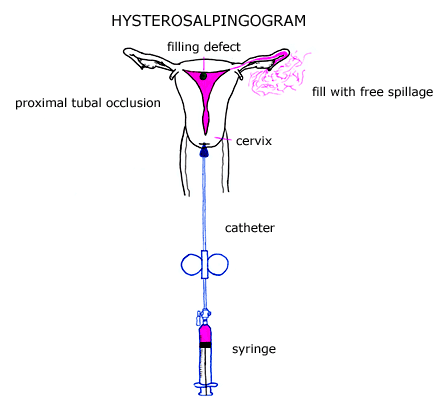|

This exam is usually done within a radiology suite that is equipped with an x-ray machine capable of flouroscopy and a monitor (to view the study in progress from beginning to end). A speculum is placed within the vaginal vault and the cervix centered. A catheter with a balloon tip can be fed through the cervix into the uterine cavity or the anterior lip of the outer cervix can be grasped with a tenaculum (a grasping instrument) while an acorn tip catheter is inserted into the external os (opening) of the cervix (gentle pressure is applied to the cervix).
Once the vaginal instruments are in place, the patient may be repositioned, flouroscopy is turned on and radio-opaque dye (liquid that can be visualized by xray) is slowly injected into the uterine cavity so as to outline the cavity and any filling defects (usually polyps, submucosal fibroids, or adhesions). Prior to injection of dye, the catheter should be “flushed” with dye to limit the number of air bubbles that are injected into and seen within the uterus.
The dye should normally then be seen entering, filling and spilling from the fallopian tube(s). If the fallopian tube does not fill with dye, this identifies a proximal tubal occlusion, which can often be corrected with proximal tubal catheterization. If there is no spill from the distal end of the fallopian tube, it is important to distinguish a dilated (inner) tube (hydrosalpinx) from a normal appearing tube. If there is spillage of dye from the distal end of the fallopian tube this fluid normally moves freely throughout the pelvis. If there is loculated flow of dye into the pelvis, this suggests peritubal adhesions.
When the initial entry of dye into the uterine cavity is slow, there is greater ability to visualize subtle abnormalities within the uterine cavity and there is (very significantly) less patient discomfort. This test can be very uncomfortable if the operator is not careful or experienced. Therefore, I typically offer to perform this test myself for all of my patients having the procedure. My patients rarely have significant discomfort with this test.
I order prophylactic antibiotics for all of my patients undergoing hysterosalpingogram to limit the possibility of reactivation of a “dormant” infection within the reproductive tract. This is especially important for women with a history of prior tubal damage or infection.
|

|